Agents and automation both play an important role in customer experience. Automation can support many functions of customer experience– both directly and indirectly assisting customers.
An example of automation directly supporting customers is with virtual agents. These applications are customer-facing and offer self-service options for customers to complete tasks on their own.
On the other hand, automation can support customers indirectly by helping agents do their job more efficiently. This more effortless experience ripples to ease the customer’s journey as well.
This latter concept is at the heart of agent augmentation. While a lot of the benefits of AI are centered around customer experience, the elevation of agent experience should not be discounted. Beyond the reduction in operational expenses, agent experience can have a tremendous impact on the entire business.
What is Agent Augmentation?
Agent augmentation leverages the power of AI to better support agents. It allows businesses to take their customer service strategy to the next level by empowering agents with better information, useful real-time analytics, insights, and more.
So, how much do customers want to interact with a human agent versus a virtual agent? Unfortunately, it’s not a straight answer. There is no secret formula that all industries and companies must follow to achieve a perfect balance. Different use cases, different customer needs and expectations, different times of day, and different levels of intimacy require unique combinations of agent and automated support.
Having a solution that allows options for customers to self-service and get support from an agent is key. To achieve this, both customer-facing and non-customer-facing applications must be high-quality and integrated to allow a seamless experience.
Let’s explore the levels of agent augmentation to see the varying degrees of involvement and sophistication that can be offered.
Level 1:
When there is no automation in place, customers have to wait in a queue to speak to an agent to solve any issue or question. Beyond long waits, there’s no warm hand-off, customers have to repeat information, and agents spend maximum effort when searching for customer or business information.
Level 2:
Limited automation enables self-service to a certain point. However, any complex requests must be taken care of by an agent, as the automation is not sophisticated enough to handle it. This could require waiting, adding frustration as customers are spending longer to get a simple issue resolved. Agents have to toggle between multiple screens and data sources to find the needed information.
Level 3:
In every interaction, the customer must talk to a live agent. Live agents are supported through AI with hints and other assisted information.
Level 4:
The customer only interacts with a conversational and engaging Intelligent Virtual Assistant (IVA). The IVA digitally engages with an agent to get a response, and the IVA sends that response back to the customer. This is a faster, more efficient way of executing the task, and lowers operational costs.
Level four offers the most sophisticated degree of agent augmentation, resulting in the most benefits for both customers and the business. While it’s always important to have options for customers to leave automation, offering a solution that supports customers in a way that is natural, easy, and productive will usually translate into customers not wanting to leave the automation.



